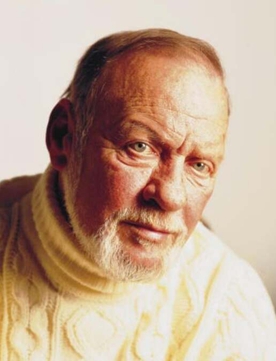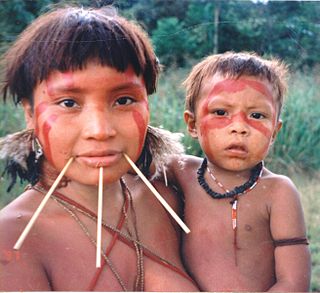
The Arawak are a group of Indigenous peoples of northern South America and of the Caribbean. The term "Arawak" has been applied at various times to different Indigenous groups, from the Lokono of South America to the Taíno, who lived in the Greater Antilles and northern Lesser Antilles in the Caribbean. All these groups spoke related Arawakan languages.
The Adlet are a race of creatures in the Inuit mythology of Greenland, as well as the Labrador and Hudson Bay coasts. While the word refers to inland native American tribes, it also denotes a humanoid dog-legged tribe. The lower part of the body of the canine Adlet is like that of a dog and their upper part is like a man's. All Adlet run quickly, and their encounters with men usually end with man as the victor.

The Fort Parker massacre, also known as the Fort Parker raid, was an event in which a group of Texian colonists were killed in an attack by a contingent of Comanche, Kiowa, Caddo, and Wichita raiders at Fort Parker on May 19, 1836. During the attack, Cynthia Ann Parker, then approximately nine years old, was captured and spent most of the rest of her life within the Comanche Nation, later marrying Chief Peta Nocona and giving birth to three children, including a son, Quanah Parker, who became a prominent leader of the Comanches and a war leader during the Red River War of 1874–75. Cynthia’s brother John Richard Parker was also captured and remained with the Comanches for six years before his release was negotiated. He was unable to readapt to Western society and chose to return to the Comanche Nation.

Cynthia Ann Parker, Naduah, Narua, or Preloch, was a woman who was captured, aged around nine, by a Comanche band during the Fort Parker massacre in 1836, where several of her relatives were killed. She was taken with several of her family members, including her younger brother John Richard Parker. Parker was later adopted into the tribe and had three children with a chief. Twenty-four years later she was relocated and taken captive by Texas Rangers, aged approximately 33, and unwillingly forced to separate from her sons and conform to European-American society. Her Comanche name means "was found" or "someone found" in English.

Napoleon Alphonseau Chagnon was an American cultural anthropologist, professor of sociocultural anthropology at the University of Missouri in Columbia and member of the National Academy of Sciences. Chagnon was known for his long-term ethnographic field work among the Yanomamö, a society of indigenous tribal Amazonians, in which he used an evolutionary approach to understand social behavior in terms of genetic relatedness. His work centered on the analysis of violence among tribal peoples, and, using socio-biological analyses, he advanced the argument that violence among the Yanomami is fueled by an evolutionary process in which successful warriors have more offspring. His 1967 ethnography Yanomamö: The Fierce People became a bestseller and is frequently assigned in introductory anthropology courses.

Olive Ann Oatman was a White American woman who was enslaved and later released by Native Americans in the Mojave Desert region when she was a teenager. She later lectured about her experiences.

Bride kidnapping, also known as marriage by abduction or marriage by capture, is a practice in which a man abducts the woman he wishes to marry.

City of the Beasts is the first young adult novel by Chilean-American writer Isabel Allende. Published in 2002, the story is set in the Amazon rainforest. The novel was translated by Margaret Sayers Peden from Spanish to English. Walden Media acquired the novel's movie rights in 2006, but no film has yet been produced.

Judith R. Shapiro is a former President of Barnard College, a liberal arts college for women at Columbia University. Prior to her role at Barnard, she had a teaching career as a cultural anthropologist at Bryn Mawr College and The University of Chicago. She served as president of the Teagle Foundation from 2013-2018.

The Emerald Forest is a 1985 British adventure drama film set in the Brazilian rainforest, directed by John Boorman, written by Rospo Pallenberg, and starring Powers Boothe, Meg Foster, and Charley Boorman with supporting roles by Rui Polanah, Tetchie Agbayani, Dira Paes, Estee Chandler, and Eduardo Conde.
Julia Kapatelis and her daughter Vanessa "Nessie" Kapatelis are fictional characters created by writer/artist George Pérez for the Wonder Woman ongoing series published by DC Comics. Debuting in 1987, the Kapatelises would serve as recurring supporting characters for Wonder Woman until the 2000s.

Fools Crow is a 1986 novel written by Native American author James Welch. Set in Montana shortly after the Civil War, this novel tells of White Man's Dog, a young Blackfeet Indian on the verge of manhood, and his band, known as the Lone Eaters. The invasion of white society threatens to change their traditional way of life, and they must choose to fight or assimilate. The story is a portrait of a culture under pressure from colonization. The story culminates with the historic Marias Massacre of 1870, in which the U.S. Cavalry killed a friendly band of Blackfeet, consisting mostly of non-combatants.

The Council House Fight, often referred to as the Council House Massacre, was a fight between soldiers and officials of the Republic of Texas and a delegation of Comanche chiefs during a peace conference in San Antonio on March 19, 1840. About 35 Comanche men and women under chief, Mukwooru represented just a fraction of the Penateka band of the southern portion of the Comanche tribe. He knew he had no authority to speak for the Southern tribes as a whole and thus, any discussions of peace would be simply a farce. However, if Mukwooru could re-establish a lucrative trade with the San Antonian's perhaps a peace, by proxy, could be established. Just as the Comanche had done had been done for centuries in San Antonio, Santa Fe and along the Rio Grande River. They would rob one settlement and then sell to the other.
Florinda Donner is an American writer and anthropologist known as one of Carlos Castaneda's "witches".
Raptio is a Latin term for, among several other meanings for senses of "taking", the large-scale abduction of women: kidnapping for marriage, concubinage or sexual slavery. The equivalent German term is Frauenraub.

The Yanomami, also spelled Yąnomamö or Yanomama, are a group of approximately 35,000 indigenous people who live in some 200–250 villages in the Amazon rainforest on the border between Venezuela and Brazil.

The Yanomami people are an indigenous group who live in the Amazon Rainforest along the borders of Venezuela and Brazil. There are estimated to be only approximately 35,000 indigenous people remaining. They are interfluvial Indians who live in small villages along the Mavaca and Orinoco Rivers, with each village consisting of a single shabono, or communal dwelling. Largely uncontacted by the outside world, the Yanomami have been affected by illnesses introduced by gold miners since the 1980s. Anthropological studies have emphasized that the Yanomami are a violent people, and although this can be true, the women of the Yanomami culture generally abstain from violence and warfare. Although males dominate the Yanomami culture, Yanomami women play an important role in sustaining their lifestyle.
Kenneth Robert Good is an anthropologist most noted for his work among the Yanomami and his account of his experiences with them: Into the Heart: One Man’s Pursuit of Love and Knowledge Among the Yanomami. While researching and living with the group in Venezuela, Good married a Yanomami girl named Yarima, who emigrated to the United States with Good when he returned home. Their three children were raised in the United States, but Yarima, finding adapting to life in the United States too difficult, returned to her village when the children were young.
The genocide of indigenous peoples in Brazil began with the Portuguese colonization of the Americas, when Pedro Álvares Cabral made landfall in what is now the country of Brazil in 1500. This started the process that led to the depopulation of the indigenous peoples in Brazil, because of disease and violent treatment by Portuguese settlers, and their gradual replacement with colonists from Europe and enslaved peoples from Africa. This process has been described as a genocide, and continues into the modern era with the ongoing destruction of indigenous peoples of the Amazonian region.

Ishi in Two Worlds is a biographical account of Ishi, the last known member of the Yahi Native American people. Written by American author Theodora Kroeber, it was first published in 1961. Ishi had been found alone and starving outside Oroville, California, in 1911. He was befriended by the anthropologists Alfred Louis Kroeber and Thomas Waterman, who took him to the Museum of Anthropology in San Francisco. There, he was studied by the anthropologists, before his death in 1916. Theodora Kroeber married Alfred Kroeber in 1926. Though she had never met Ishi, she decided to write a biography of him because her husband did not feel able to do so.













